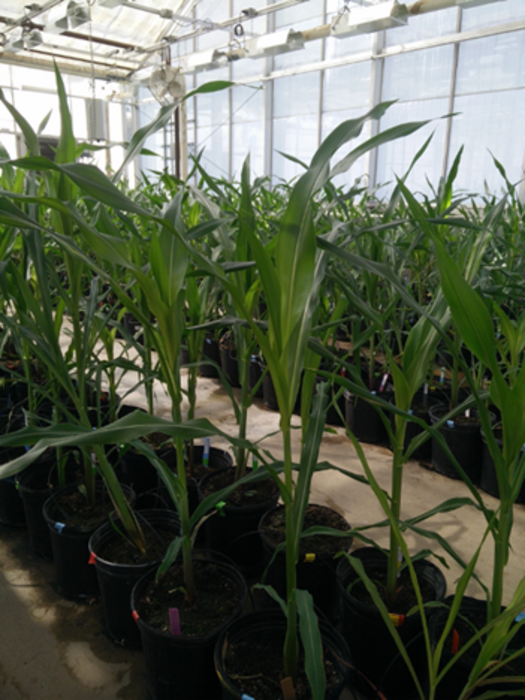At today’s backyard barbeques, we enjoy corn on the cob with hundreds of sweet juicy kernels. But if we were eating teosinte, the wild ancestor of corn, we would be lucky to enjoy a dozen kernels per ear. In fact, many of our modern crops bear little resemblance to their wild ancestors. Thanks to thousands of years of breeding, or “artificial selection,” today’s crops are tasty and produce high yields. However, they may have undergone additional changes that are harder to see (or taste).

Credit: Alonso Favela
At today’s backyard barbeques, we enjoy corn on the cob with hundreds of sweet juicy kernels. But if we were eating teosinte, the wild ancestor of corn, we would be lucky to enjoy a dozen kernels per ear. In fact, many of our modern crops bear little resemblance to their wild ancestors. Thanks to thousands of years of breeding, or “artificial selection,” today’s crops are tasty and produce high yields. However, they may have undergone additional changes that are harder to see (or taste).
While humans have improved crops to suit our tastes and agricultural systems, the selection process can also alter traits that breeders did not intentionally target. In breeding crops for modern agriculture, we may have inadvertently made the plants more reliant on inputs such as fertilizers, which are energy-intensive to produce and often cause nutrient pollution. Studies suggest that the microbial communities associated with maize have shifted over its history of domestication. These microbes can play important roles in ecosystem processes like nitrogen cycling, converting nitrogen to forms that plants can readily access and use.
In “N-Cycling Microbiome Recruitment Differences Between Modern and Wild Zea maysa”—published by Phytobiomes Journal in June— Alonso Favela, Martin Bohn, and Angela Kent investigated these evolutionary changes in root-associated microbe recruitment. To do so, they grew both modern domesticated maize and wild teosinte in a greenhouse and introduced similar soil microbial communities. Once the plants had grown, the soil surrounding their roots was collected. The researchers then used DNA sequencing to study the makeup of each plant’s microbiome, including genes related to nitrogen cycling.
The researchers found that domesticated plants recruited different microbes from the soil than their wild relatives, including microbes that are involved in nitrogen cycling. Whether the plant was wild or domesticated explained 62% of the variation in the associated microbial communities’ nitrogen cycling gene diversity, and 66% of the nitrogen cycling gene abundance. In other words, thousands of years of artificial selection seems to have driven substantial differences in the ways that these crops recruit assistance from microbes to access nitrogen. Looking into maize’s evolutionary past may provide clues to how these plants could thrive without heavy reliance on synthetic fertilizers. “Understanding how wild teosinte shapes its N-cycling microbiome may allow us to bring these traits to modern maize production to improve nutrient sustainability” explains lead author Favela.
“This [research] highlights the potential to use genetic variation from teosinte to ‘rewild’ our modern agricultural crops microbiome to make a more sustainable and effective agricultural system,” Favela states. If we can breed crops that are better at recruiting helpful microbes like their ancestors, we could reduce our reliance on synthetic fertilizers and curtail the nutrient pollution that is destroying so many ecosystems.
To learn more, read Volume 6, Number 2 / 2022 of Phytobiomes Journal.
Phytobiomes Journal publishes transdisciplinary research on organisms and communities interacting with plants in any ecosystem. It includes the fundamental to translational work of scientists in the areas of microbiology, virology, nutrient cycling, climate change, ecology, agronomy, entomology, computational biology, nematology, plant pathology, and more.
The lead researcher, Alonso Favela (@AlonsoFlagella, LinkedIn https://www.linkedin.com/in/alonsofavela/), is currently an NIFA Postdoctoral Research Associate working to improve the agricultural sustainability of modern maize. He is a proud first-generation Mexican American Scientist. He hopes to find a position as an assistant professor where he can study the genes and traits involved in microorganism recruitment to the plant microbiome.
You can find his co-authors Martin Bohn at @MartinBohn10 and Angela Kent at @DrAngelaKent.
News release prepared by:
Lauren Martin is a recent graduate from Indiana University. She completed her undergraduate thesis on the effects of nitrogen on plant-rhizobia mutualisms and local decomposition rates in Jen Lau’s lab. Her interests broadly span ecology, evolution, and environmental science.
Mia Howard (@mia_how) is an assistant feature editor for Phytobiomes Journal and a postdoctoral researcher in Jen Lau’s lab at Indiana University. She is fascinated by how plants—often with help from microbes—protect themselves from herbivores with toxic chemicals.
Journal
Phytobiomes Journal
DOI
10.1094/PBIOMES-08-21-0049-R
Article Title
N-cycling microbiome recruitment differences between modern and wild Zea mays
Article Publication Date
7-Jun-2022
COI Statement
The author(s) declare no conflict of interest.




